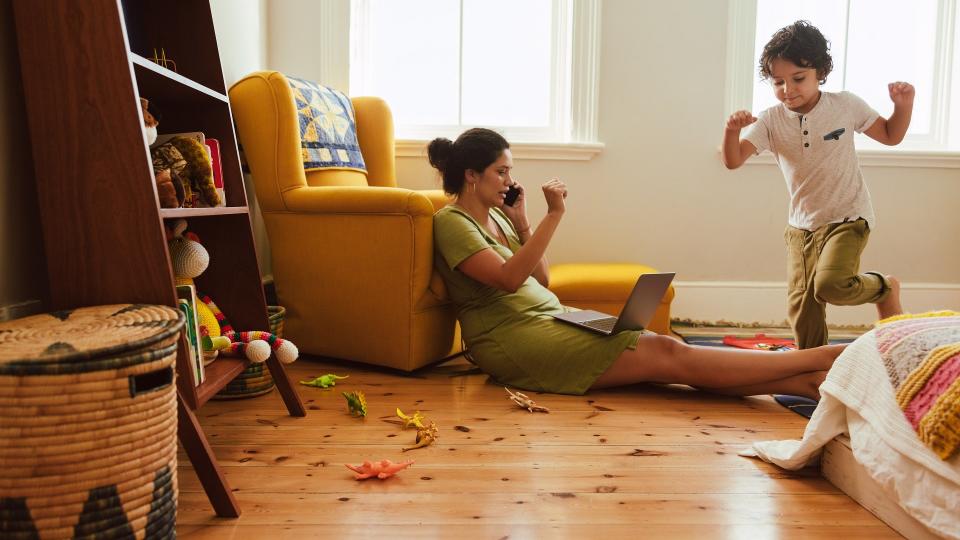Remote Jobs and Women: How Working From Home Has Altered the Family Dynamic, Mental Health and More

Earlier this year, Forbes published an article that asked, “Could the new hybrid workplace turn some women into second-class employees?” It focused on the very delicate work-life balance that pervades women’s roles as part of a household and as mothers.
Examining the Gender Pay Gap: Industries Where Women Still Make Less Despite More Challenges
Social Security: Women Get $354 Per Month Less Than Men – Here’s Why
So, does the changing work environment provide freedom or sacrifice career opportunities?
Bloomberg picked up the conversation recently by interviewing a number of women who were working from home, finding they were becoming “one-woman safety nets.”
While there have been some positives, like taking away commuting times, offering more flexibility to be present for kids’ activities and not having to deal with pregnancies and even postpartum experiences in male-dominated offices, there are some drawbacks, too.
When looking at the dynamic of a nuclear family scenario, for example, mothers that work from home have found their caretaker role expanded even more than before. As the New York Times reported, early on in the pandemic, when working from home became a more regular standard, the change created a “child care crisis.” It’s said 5.1 million mothers stopped working in order to care for and home-school kids who no longer had outside options.
To put it into context, Wendy Chun-Hoon, director of the U.S. Department of Labor’s Women’s Bureau, told the National Conference of State Legislatures, “We have tons of data showing that women still take up the majority of caregiving and household work — that is the unpaid work, but still work. You couple that with a lack of care infrastructure and three million women have suddenly gone from the workplace.”
As Forbes added, the percentage of women in the American workforce is currently the same as in the1980s before a revolutionary twist in which more women were seeking full-time employment.
Women still largely desire the opportunity to work from home — according to a FlexJobs survey, 60% of women said they would quit their job if their company made them go back to the office full time. And 80% said that when looking for a new job, remote work positions are the most desirable factor when considering the opportunity.
More: 6 Alternative Investments To Consider for Diversification in 2022
Yet, working from home and caring for the household and children has caused record burnout “because the multitasking is way too intense,” Misty Heggeness told Forbes after leading a study for the U.S. Census Bureau about women leaving their jobs. So many women left work behind at the start of the pandemic that it took on a term known as a “she-cession,” per Bloomberg.
But now, with more women tiptoeing back into the workforce with remote opportunities, the burden of being a caretaker and employee is weighing on many. Part of the problem, per Bloomberg, is that before the pandemic-fueled work from home scenario, families had systems in place for emergencies such as children coming home sick from school. Parents generally split the responsibility, but with mothers now working more and more from home, boundaries have been blurred; the parent who is home is the default caretaker.
Of course, this can apply to men who work from home, too — but less men desire to. Bloomberg pointed to a Future Forum study that discovered men are begging to go back to the office, with 44% of male executives desiring non-remote structures.
Not only that, but many men who are returning to the office are the ones getting job advancement opportunities, as those who get promoted are normally the ones who are physically present, according to Bloomberg. This can lead to a scenario where women feel less valued in the workplace.
According to the Women At Work survey done by Deloitte earlier this year, 53% of the participants said that they were experiencing more stress than a year ago, and 33% had taken time off to focus on their mental health. With these strong indicators, it’s become more and more important for interventions to tackle some of the obstacles that women are facing in this new work structure.
There are some fixes that have been suggested. The first would be federal actions to provide more government-sanctioned programs. CNN recently reported on the fact that the Inflation Reduction Act wholly ignored working parents by removing any opportunities for paid family and sick leave, better child tax credits and universal pre-kindergarten programs. It was the ninth time in nearly three years when “proposed legislation aimed at helping women and families have been removed,” they noted, after looking into data from the Congressional Budget Office and Congressional Research Reports.
Forbes has also pointed to some employers that are making hybrid workplace culture more intentional and fair. Some are ensuring performance reviews do not give remote workers an unfair bias, while others have set a standard for meetings between a “prime time” of 11 a.m. to 2 p.m. to ensure work-from-home employees can attend.
Financially Savvy Female: How You Can Support Other Women With Your Investment Dollars
Explore: The 10 Best Side Hustles for Women
There are also newer resources cropping up like the website The Work at Home Woman, which curates job postings and articles catered to working mothers to lead to the most successful outcomes as this workplace shift continues to evolve.
More From GOBankingRates
This article originally appeared on GOBankingRates.com: Remote Jobs and Women: How Working From Home Has Altered the Family Dynamic, Mental Health and More
